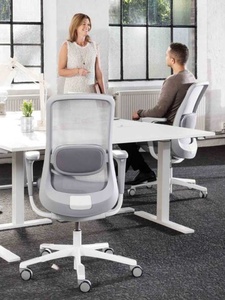Over a Dentist's career the likelihood of experiencing work related pain of some sort is startlingly high. Be it an occasional back or neck ache or more regular pains which can accumulate into a serious issue, how dentists manage their health at work is vital for longevity in their job. Today a large proportion of Dental professionals experience recurring musculoskeletal pain and are at an elevated risk of developing serious Musculoskeletal Disorders (MSD’s). In order to understand the root of these issues and to minimize the risks of developing a work-related injury an understanding of the physiological mechanisms that lead to these problems is necessary. This piece will look at why Dentists have sore backs and what can be done to prevent injury occurring.
For Oral Healthcare professionals who mainly sit or stand the most common risk factors that cause MSD’s are;
• Poor personal working habits
• Prolonged static postures
• Poor physical fitness
• Repetitive movements (twisting, fine hand movements)
• Poor positioning (forward bending, twisting particularly, too far from patient)
• Poor job design
Other factors may include:
• Age
• Smoking
• Poor nutrition
• Overweight
• Stress
• Sub-optimal lighting
Usually musculoskeletal pain and MSD’s common to Dental professionals are multifactorial. There is a link between prolonged, static (motionless) muscle contractions and muscle ischemia or necrosis (death of most cells in a muscle due to injury). Weak postural muscles of the core and shoulders may lead to poor posture during work with patients. Muscles are designed to adapt by lengthening or shortening to accommodate these postures, therefore prolonged poor posture may result in a muscle imbalance, leading to structural damage and pain.
Dentists need to understand the mechanisms surrounding oral pathology to treat patients effectively. In order to be able to work safely and efficiently over their career a knowledge of the mechanisms contributing to MSD’s is also vital. This knowledge will allow them to make educated choices relating to exercise, equipment, ergonomics and lifestyle. With this knowledge dentists will be empowered to prevent and manage work related MSD’s in Dentistry.
Common Musculoskeletal Disorders
Within dentistry the most recurring MSD’s that occur include chronic lower back pain. Unfortunately, this can lead to referred pain down the hip, buttocks and down one or both legs. The root cause of this pain may be a muscle strain or trigger points, weak postural muscles or spinal injuries like a bulging/herniated disc.
Rates of neck pain have also risen among Dentists. Here an initial stiffness and muscle spasm in the cervical musculature can lead to referred pain down between the shoulder blades or up to the occiput. Adjacent cervical nerve roots can become inflamed resulting in numbness and/ or tingling at the arm or hand. A repeated forward head tilt from leaning over patients may precede this issue, leading to muscle imbalances, ischemia or cervical disc degeneration.
When it comes to tendon disorders in the upper limb, tasks that require repetitive movements tend to be the main culprit. These conditions usually begin as slight discomfort and eventually lead to chronic discomfort.
Another condition that has risen in prevalence is sub-acromial impingement syndrome. This condition is characterised by pain in the shoulder when overreaching, sustained elevation of the arm or sleeping on the affected arm. Poor body mechanics and an overly rounded shoulder posture during work can lead to this impingement.
Common Symptoms
In the early stages of an injury, dentists experience aches & pains at the end of a long day’s work. These symptoms may ease with movement but are aggravated by prolonged static positions. Early symptoms can usually be resolved with simple measures.
If symptoms progress and worsen i.e. referred pain & limited activity it is suggested that individuals seek professional advice in the management of such a condition, before symptoms progress any further.
Unfortunately, surgery is not uncommon, particularly when symptoms are not prevented or addressed at an earlier stage. MSD’s have resulted in reduced productivity in the dentistry profession due to elevated absenteeism or early retirement.
How to prevent MSD’s
• Good postural positioning (strive to maintain a neutral, balanced posture)
• Frequent strengthening exercises
• Common work habits
• Good use and selection of ergonomic equipment
• Frequent shorter breaks
• Professional advice as appropriate
Over the coming weeks I will delve further into specific aspects of Dental ergonomics, focusing on increasing performance at work and how Dentists can minimize the risk of injury.
For more information regarding workplace ergonomics among dentists or to arrange a Free Consultation with one of our Ergonomic Consultants at our Dublin City Centre Showroom on Clare Street (Near Merrion Square, opposite the National Art Gallery) get in touch on 01 6110200 or email sales@kos.ie















